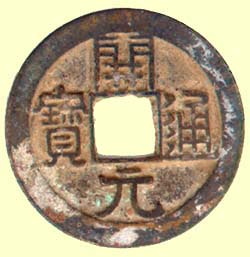
Ancient Chinese Coins Display a Diversity of Character Styles
The coin on the left is an example of the Wu Shu, or "Five Unit" currency introduced during the reign of the Han emperor Wu Ti in 118 B. C. The inscription on this coin is in the Small Seal style, introduced during the reign of Q'in Shih Huang Ti of the previous Q'in (pronounced "Chin") Dynasty. The hourglass shaped character on the right is an early form of the character for "Five".
 The Chinese "Spade Money" displayed at right was issued by the emperor Wang Mang (A. D. 7 - 22) and illustrates a fine example of a variation of early Chinese Greater Seal script characters on the obverse (front) of the piece. The Greater Seal style was introduced by an official during the reign of the emperor Chou Hsuan (827 - 782 B. C.). The usurper Wang Mang was an admirer of the ancient style of currency, so he re-introduced the obsolete spade money. The Greater Seal style of inscription is recognizable by its long, flowing lines.
The Chinese "Spade Money" displayed at right was issued by the emperor Wang Mang (A. D. 7 - 22) and illustrates a fine example of a variation of early Chinese Greater Seal script characters on the obverse (front) of the piece. The Greater Seal style was introduced by an official during the reign of the emperor Chou Hsuan (827 - 782 B. C.). The usurper Wang Mang was an admirer of the ancient style of currency, so he re-introduced the obsolete spade money. The Greater Seal style of inscription is recognizable by its long, flowing lines.
 The bottom coin on the left is a much later coin from the T'ang Dynasty. The characters are of the style known as Clerical Style or Official Style. Though the strokes in the characters are more rounded and flowing than in the modern script or even calligraphic styles of the last 500 years, they are more compact than either the Greater Seal or the Small Seal Styles.
The bottom coin on the left is a much later coin from the T'ang Dynasty. The characters are of the style known as Clerical Style or Official Style. Though the strokes in the characters are more rounded and flowing than in the modern script or even calligraphic styles of the last 500 years, they are more compact than either the Greater Seal or the Small Seal Styles.
Return to History of Communications Timeline
 The Chinese "Spade Money" displayed at right was issued by the emperor Wang Mang (A. D. 7 - 22) and illustrates a fine example of a variation of early Chinese Greater Seal script characters on the obverse (front) of the piece. The Greater Seal style was introduced by an official during the reign of the emperor Chou Hsuan (827 - 782 B. C.). The usurper Wang Mang was an admirer of the ancient style of currency, so he re-introduced the obsolete spade money. The Greater Seal style of inscription is recognizable by its long, flowing lines.
The Chinese "Spade Money" displayed at right was issued by the emperor Wang Mang (A. D. 7 - 22) and illustrates a fine example of a variation of early Chinese Greater Seal script characters on the obverse (front) of the piece. The Greater Seal style was introduced by an official during the reign of the emperor Chou Hsuan (827 - 782 B. C.). The usurper Wang Mang was an admirer of the ancient style of currency, so he re-introduced the obsolete spade money. The Greater Seal style of inscription is recognizable by its long, flowing lines.

 The bottom coin on the left is a much later coin from the T'ang Dynasty. The characters are of the style known as Clerical Style or Official Style. Though the strokes in the characters are more rounded and flowing than in the modern script or even calligraphic styles of the last 500 years, they are more compact than either the Greater Seal or the Small Seal Styles.
The bottom coin on the left is a much later coin from the T'ang Dynasty. The characters are of the style known as Clerical Style or Official Style. Though the strokes in the characters are more rounded and flowing than in the modern script or even calligraphic styles of the last 500 years, they are more compact than either the Greater Seal or the Small Seal Styles.